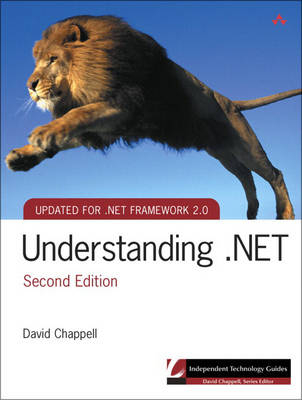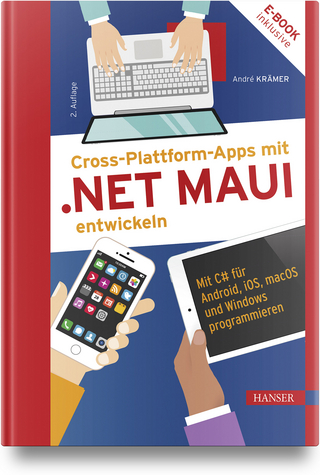
Understanding .NET
Addison-Wesley Educational Publishers Inc (Verlag)
978-0-321-19404-6 (ISBN)
- Titel ist leider vergriffen;
keine Neuauflage - Artikel merken
Microsoft's .NET is revolutionizing Windows-based software development. Since its initial release in 2002, .NET has changed significantly, becoming the foundation for a new generation of Windows applications. The .NET Framework and Visual Studio, the two core aspects of this initiative, provide a multilanguage environment in which developers can create Web services, graphical user interfaces, and other kinds of applications. Taken as a whole, the .NET technologies have changed the way nearly every Windows application is built.
Now fully updated for version 2.0 of the .NET Framework and Visual Basic 2005, Understanding .NET, Second Edition, is a concise guide to the landscape of Windows development. Margin notes, detailed diagrams, and lucid writing make this book easy to read and navigate, while analysis sections explore controversial issues and address common concerns. David Chappell's independent perspective and straightforward descriptions clarify both how the .NET technologies work and how they can be used.
Coverage includes
An overview of .NET and its goals
The Common Language Runtime (CLR)
The .NET languages, including C#, Visual Basic, and C++
The .NET Framework class library
Building Web Applications with ASP.NET
Accessing Data with ADO.NET
.NET framework integration with SQL Server 2005
The key to using a new technology is to understand the fundamentals. This book provides the robust foundation developers and technical managers need to make the right decisions and maximize the potential of this revolutionary framework.
David Chappell is Principal of Chappell & Associates and the best-selling author of Understanding ActiveX and OLE (Microsoft Press) and other books. Through his speaking, writing, and consulting, David helps information technology professionals around the world understand, use, and make better decisions about new technologies.
Preface xiii Chapter 1: INTRODUCING .NET 1 The .NET Framework 3
The Common Language Runtime 7
The .NET Framework Class Library 12
Visual Studio 2005 21
General Purpose Languages 25
Domain Specific Languages 30
Working in Groups: Visual Studio Team System 33
Conclusion 35
Chapter 2: THE COMMON LANGUAGE RUNTIME 37 Building Managed Code: The Common Type System 38
Introducing the Common Type System 39
A Closer Look at CTS Types 42
Converting Value Types to Reference Types: Boxing 46
The Common Language Specification 47
Compiling Managed Code 48
Microsoft Intermediate Language (MSIL) 49
Metadata 52
Organizing Managed Code: Assemblies 54
Metadata for Assemblies: Manifests 54
Categorizing Assemblies 57
Executing Managed Code 58
Loading Assemblies 58
Compiling MSIL 60
Creating a Native Image: NGEN 63
Securing Assemblies 64
Garbage Collection 70
Application Domains 73
Conclusion 75
Chapter 3: .NET LANGUAGES 77 C# 79
A C# Example 79
C# Types 82
C# Control Structures 97
Other C# Features 98
Visual Basic 107
A VB Example 108
VB Types 111
VB Control Structures 124
Other VB Features 125
C++ 130 C++/CLI 132
Managed C++ 136
Conclusion 140
Chapter 4: SURVEYING THE .NET FRAMEWORK CLASS LIBRARY 143 An Overview of the Library 143
The System Namespace 144
A Survey of System's Subordinate Namespaces 145
Fundamental Namespaces 156
Input and Output: System.IO 156
Serialization: System.Runtime.Serialization 159
Reflection: System.Reflection 163
XML: System.Xml 166
Transactions: System.Transactions 175
Interoperability: System.Runtime.InteropServices 179
Windows GUIs: System.Windows.Forms 184
Conclusion 195
Chapter 5: BUILDING WEB APPLICATIONS: ASP.NET 197 ASP.NET Applications: Basics 198
Creating .aspx Files 200
Using Web Controls 204
Separating User Interface from Code: Code-Behind 209
Defining Applications 211
Using Context Information 213
ASP.NET Applications: Beyond the Basics 215
Managing State 216
Caching Data 221
Authentication and Authorization 222
Managing Users: Membership 224
Working with Data: Data Binding 225
Customizing User Interfaces: Web Parts 228
Conclusion 230
Chapter 6: ACCESSING DATA: ADO.NET 231 Using .NET Framework Data Providers 232
Using Connection and Command Objects 237
Accessing Data with DataReaders 239
Accessing Data with DataSets 243
Creating and Using DataSets 245
Accessing and Modifying a DataSet's Contents 250
Using DataSets with XML-Defined Data 253
Conclusion 260
Chapter 7: BUILDING DISTRIBUTED APPLICATIONS 261 ASP.NET Web Services: System.Web.Services 261
Web Services Fundamentals 262
ASP.NET Web Services Applications: Basics 265
ASP.NET Web Services Applications: Beyond the Basics 269
.NET Remoting: System.Runtime.Remoting 273
An Overview of the Remoting Process 274
Passing Information to Remote Objects 276
Choosing a Channel 278
Creating and Destroying Remote Objects 281
Enterprise Services: System.EnterpriseServices 288
What Enterprise Services Provides 288
Enterprise Services and COM+ 291
Final Thoughts 295
About the Author 297 Index 299
| Erscheint lt. Verlag | 25.5.2006 |
|---|---|
| Reihe/Serie | Independent Technology Guides |
| Verlagsort | New Jersey |
| Sprache | englisch |
| Maße | 177 x 234 mm |
| Gewicht | 650 g |
| Themenwelt | Informatik ► Programmiersprachen / -werkzeuge ► NET Programmierung |
| ISBN-10 | 0-321-19404-7 / 0321194047 |
| ISBN-13 | 978-0-321-19404-6 / 9780321194046 |
| Zustand | Neuware |
| Haben Sie eine Frage zum Produkt? |
aus dem Bereich


